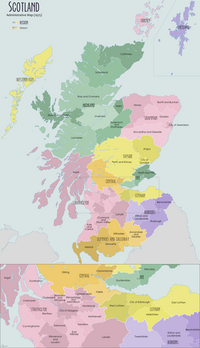Dumfries and Galloway
 From Wikipedia - Reading time: 22 min
From Wikipedia - Reading time: 22 min
Dumfries and Galloway
| |
|---|---|
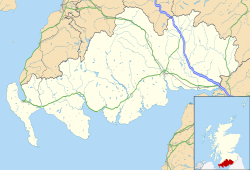 Dumfries and Galloway shown within Scotland | |
| Coordinates: 55°06′N 3°54′W / 55.1°N 3.9°W | |
| Sovereign state | United Kingdom |
| Country | Scotland |
| Lieutenancy areas | |
| Unitary authority | 1 April 1996 |
| Administrative HQ | County Buildings, Dumfries |
| Government | |
| • Type | Council |
| • Body | Dumfries and Galloway Council |
| • Control | No overall control |
| Area | |
• Total | 2,481 sq mi (6,426 km2) |
| • Rank | 3rd |
| Population (2022)[2] | |
• Total | 145,770 |
| • Rank | 14th |
| • Density | 60/sq mi (23/km2) |
| Time zone | UTC+0 (GMT) |
| • Summer (DST) | UTC+1 (BST) |
| ISO 3166 code | GB-DGY |
| GSS code | S12000006 |
| Website | dumgal |
Dumfries and Galloway (Scots: Dumfries an Gallowa; Scottish Gaelic: Dùn Phrìs is Gall-Ghaidhealaibh) is one of the 32 unitary council areas of Scotland, located in the western part of the Southern Uplands. It is bordered by East Ayrshire, South Ayrshire, and South Lanarkshire to the north; Scottish Borders to the north-east; the English county of Cumbria, the Solway Firth, and the Irish Sea to the south, and the North Channel to the west. The administrative centre and largest settlement is the town of Dumfries. The second largest town is Stranraer, located 76 miles (122 km) to the west of Dumfries on the North Channel coast.
Dumfries and Galloway corresponds to the historic shires of Dumfriesshire, Kirkcudbrightshire, and Wigtownshire, the last two of which are collectively known as Galloway. The three counties were combined in 1975 to form a single region, with four districts within it. The districts were abolished in 1996, since when Dumfries and Galloway has been a unitary local authority. For lieutenancy purposes, the area is divided into three lieutenancy areas called Dumfries, Wigtown, and the Stewartry of Kirkcudbright, broadly corresponding to the three historic counties.
History and geography
[edit]History
[edit]The term Dumfries and Galloway has been used since at least the 19th century – by 1911 the three counties had a united sheriffdom under that name. Dumfries and Galloway covers the majority of the western area of the Southern Uplands,[3] it also hosts Scotland's most Southerly point, at the Mull of Galloway[4] in the west of the region.
Geography
[edit]


Regions
[edit]The Dumfries and Galloway Council region is composed of counties and their sub-areas. From east to west:
- Dumfriesshire County
- Kirkcudbrightshire County
- Wigtownshire County
- the sub-area of Wigtownshire – Machars (archaically, Farines)--divided into census areas (civil parish areas)
- the sub-area of Wigtownshire – Rhins of Galloway divided into census areas (civil parish areas)
Water systems
[edit]The region has a number of south running water systems which break through the Southern Uplands creating the main road, and rail, arteries north–south through the region and breaking the hills up into a number of ranges.
- River Cree valley carries the A714 north-westward from Newton Stewart to Girvan and Water of Minnoch valley which lies just west of the Galloway Hills carries a minor road northward through Glentrool village into South Ayrshire. This road leaves the A714 at Bargrennan.
- Water of Ken and River Dee form a corridor through the hills called the Glenkens[5] which carries the A713 road from Castle Douglas to Ayr. The Galloway Hills lie to the west of this route through the hills and the Carsphairn and Scaur Hills lie to the east.
- River Nith rises between Dalmellington and New Cumnock in Ayrshire and runs east then south down Nithsdale to Dumfries. Nithsdale carries both the A76 road and the rail line from Dumfries to Kilmarnock. It separates the Carsphairn and Scaur Hills from the Lowther Hills which lie east of the Nith.
- River Annan combines with Evan Water and the River Clyde to form one of the principal routes into central Scotland from England – through Annandale and Clydesdale – carrying the M74 and the west coast railway line. This gap through the hills separates the Lowthers from the Moffat Hills.
- River Esk enters the Solway Firth just south of Gretna having travelled south from Langholm and Eskdalemuir. The A7 travels up Eskdale as far as Langholm and from Langholm carries on up the valley of Ewes Water to Teviothead where it starts to follow the River Teviot to Hawick. Eskdale itself heads north west from Langholm through Bentpath and Eskdalemuir to Ettrick and Selkirk.
Transportation
[edit]The A701 branches off the M74 at Beattock, goes through the town of Moffat, climbs to Annanhead above the Devil's Beef Tub (at the source of the River Annan) before passing the source of the River Tweed and carrying on to Edinburgh. Until fairly recent times the ancient route to Edinburgh travelled right up Annandale to the Beef Tub before climbing steeply to Annanhead.[6] The present road ascends northward on a ridge parallel to Annandale but to the west of it which makes for a much easier ascent.
From Moffat the A708 heads north east along the valley of Moffat Water (Moffatdale) on its way to Selkirk. Moffatdale separates the Moffat hills (to the north) from the Ettrick hills to the south.
National scenic areas
[edit]There are three National scenic areas within this region.
- Nith Estuary:[7] this area follows the River Nith southward from just south of Dumfries into the Solway Firth. Dumfries itself has a rich history going back over 800 years as a Royal Burgh (1186). It is particularly remembered as the place where Robert the Bruce murdered the Red Comyn in 1306 before being crowned King of Scotland – and where Robert Burns spent his last years. His mausoleum is in St Michael's graveyard. Going down the east bank is the village of Glencaple, Caerlaverock Castle, Caerlaverock Wild Fowl Trust, an ancient Roman fort on Ward Law Hill[8] and nearby in Ruthwell is the Ruthwell Cross and the Brow Well[9] where Robert Burns "took the waters" and bathed in the Solway just before his death. On the west bank, there are several walks and cycle routes in Mabie Forest,[10] Kirkconnell Flow[11] for the naturalist, the National Museum of Costume[12] just outside New Abbey and Sweetheart Abbey within the village. Criffel (569 metres) offers the hill walker a reasonably modest walk with views across the Solway to the Lake District. The house of John Paul Jones founder of the American Navy is also open to visitors near Kirkbean.
- East Stewartry Coast:[13] this takes in the coast line from Balcary Point[14] eastward across Auchencairn Bay and the Rough Firth past Sandyhills to Mersehead.[15] There are several coastal villages within this area – Auchencairn, Kippford, Colvend, Rockcliffe, and Portling. There is also a round tower at Orchardton and the islands of Hestan Isle and Rough Island can be reached at low tide outside the breeding season for birds. Mersehead is a wildfowl reserve. The area has a number of coastal paths.
- Fleet Valley:[16] this area takes in Fleet Bay with its holiday destinations of Auchenlarie, Mossyard Bay, Cardoness, Sandgreen and Carrick Shore. The area also includes the town of Gatehouse of Fleet and the historic villages of Anworth and Girthon – there is a castle at Cardoness in the care of Historic Scotland.
Transport
[edit]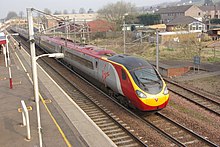

Transport in the region is operated by bus companies Houston's, Stagecoach Western, McCall's coaches, and a variety of other small operators. Train operators in the region are, ScotRail, TransPennine Express and Avanti West Coast. The region has seven working railway stations. All are on the Glasgow South Western Line, except Lockerbie which is on the West Coast Main Line.
- Stranraer railway station
- Kirkconnel railway station
- Sanquhar railway station
- Dumfries railway station
- Annan railway station
- Gretna Green railway station
- Lockerbie railway station
The mainline from Dumfries railway station via Newton Stewart to Stranraer Harbour railway station, was closed under the Beeching cuts. The line previously connected London Euston and the West Coast Main Line with the ferries to Larne Harbour railway station and the Port of Belfast.
The Port Road line to Stranraer was the last to go in June 1965, leaving only the original G&SWR main line open to serve the Stranraer. The Beeching cuts ended the Castle Douglas and Dumfries Railway and Portpatrick and Wigtownshire Railway has resulted in adverse mileage to connect Stranraer with a longer line via Kilmarnock and Ayr.
The area is served by buses which connect the main population centres. Express bus services link the main towns with Glasgow, Ayr, Edinburgh and Carlisle. Local bus services also operate across the region. Dumfries and Galloway is home to two ports which have services to Northern Ireland, both are in the West of the region. Stena Line and P&O Irish Sea both have a port in the village of Cairnryan. The region also has no commercial airports; the nearest are Glasgow Prestwick Airport and Carlisle Lake District Airport. The region does host a number of private airfields. The town of Lockerbie was the scene of the Pan Am Flight 103 terrorist attack on 21 December 1988.
The main roads to and from the region are:
Emergency services
[edit]
As with the whole of Scotland, Police Scotland is the police force for the region and Scotland as a whole since it was formed from the merger of Scotland's previous regional police forces. Its predecessor, Dumfries and Galloway Constabulary (dissolved 2014) was the smallest police force in the United Kingdom. The Scottish Fire and Rescue Service (formerly Dumfries and Galloway Fire and Rescue Service) provides firefighting services across the region. The Coastguard, Lifeboats, Moffat mountain rescue and Galloway Mountain Rescue also offer emergency services across Dumfries and Galloway.
Nith Inshore Rescue is based at Glencaple. This independent lifeboat provides water rescue cover for the River Nith, surrounding rivers and inland water. Nith Inshore Rescue is a declared facility for HM Coastguard, the control centre and overseeing authority responsible for call outs.
NHS Dumfries and Galloway provides healthcare services across the region. The two main hospitals are the Dumfries and Galloway Royal Infirmary in Dumfries and Galloway Community Hospital in Stranraer.
Education
[edit]Dumfries & Galloway Council provides nursery, primary and secondary education across the region.
Alternative Schools
[edit]Nursery and primary schools
[edit]
Secondary schools
[edit]
- Annan Academy
- Castle Douglas High School
- Dalbeattie High School
- Douglas Ewart High School, Newton Stewart
- Dalry Secondary School
- Dumfries Academy
- Dumfries High School
- Kirkcudbright Academy
- Langholm Academy
- Lockerbie Academy
- Moffat Academy
- North West Community Campus, Dumfries
- Sanquhar Academy
- St Joseph's College, Dumfries
- Stranraer Academy
- Wallace Hall, Thornhill
Culture
[edit]Wildlife
[edit]The region is known as a stronghold for several rare and protected species of amphibian, such as the Natterjack toad and the Great crested newt.[17] There are also RSPB Nature Reserves at the Mull of Galloway,[18] Wood of Cree (Galloway Forest Park),[19] Ken Dee Marshes (near Loch Ken)[20] and Mereshead (near Dalbeattie on the Solway Firth)
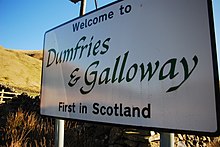
Outdoor activities
[edit]There are five 7Stanes[21] mountain biking centres in Dumfries and Galloway at Dalbeattie, Mabie, Ae, Glentrool and Kirroughtree. The Sustrans Route 7[22] long distance cycle route also runs through the region. There is excellent hill walking in the Moffat Hills,[23] Lowther Hills [24] the Carsphairn and Scaur Hills [25] and Galloway Hills.[26] The Southern Upland Way[27] coast to coast walk passes through Dumfries and Galloway and the 53-mile long Annandale Way [28] travels from the Solway Firth into the Moffat hills near the Devil's Beef Tub. There is also fresh water sailing on Castle Loch at Lochmaben[29] and at various places on Loch Ken[30] Loch Ken also offers waterskiing and wakeboarding. [31] The Solway Firth coastline offers fishing, caravaning and camping, walking and sailing.
Arts and media
[edit]Dumfries and Galloway is well known for its arts and cultural activities as well as its natural environment.[citation needed] The major festivals include the region-wide Dumfries & Galloway Arts Festival, and Spring Fling Open Studios. Other festivals include Big Burns Supper in Dumfries and the Wigtown Book Festival in Wigtown – Scotland's national book town.
In terms of television, the area is cover by BBC Scotland broadcasting from Glasgow and ITV Border which broadcast from Gateshead. Radio stations are provided by BBC Radio Scotland which broadcast the local opt-out from its studios in Dumfries and the commercial radio station, Greatest Hits Radio Dumfries & Galloway also broadcast local news bulletins to the area.
The area is served by these local newspapers:[32]
- Dumfries and Galloway Standard
- Annandale Herald
- Annandale Observer
- Dumfries Courier
- Eskdale and Liddesdale Advertiser
- Galloway Gazette
- Galloway News
- Moffat News
- Stranraer and Wigtownshire Free Press
Settlements
[edit]Largest settlements by population:
| Settlement | Population (2022)[33] |
|---|---|
| Dumfries |
33,470 |
| Stranraer |
10,110 |
| Annan |
8,760 |
| Locharbriggs |
5,610 |
| Lockerbie |
4,190 |
| Dalbeattie |
4,160 |
| Newton Stewart |
4,030 |
| Castle Douglas |
4,000 |
| Kirkcudbright |
3,350 |
| Gretna |
3,110 |
Main settlements in bold text.
- Ae, Airieland, Airds of Kells, Annan, Anwoth, Ardwell
- Beattock, Beeswing, Borgue, Brydekirk
- Caerlaverock, Cairngaan, Cairnryan, Cargenbridge, Carsphairn, Castle Douglas, Castle Kennedy, Clarencefield, Corsock, Creetown
- Dalbeattie, Dalton, Dornock, Drumlanrig, Drummore, Dumfries, Dundrennan, Dunscore
- Eastriggs, Ecclefechan, Eskdalemuir
- Garlieston, Gatehouse of Fleet, Glenluce, Gretna Green, Gretna
- Haugh of Urr, Hoddom
- Isle of Whithorn
- Johnsfield, Johnstonebridge
- Keir, Kelloholm, Kippford, Kirkbean, Kirkcolm, Kirkcowan Kirkcudbright, Kirkconnel, Kirkinner, Kirkpatrick Durham
- Langholm, Leswalt, Locharbriggs, Lochmaben, Lockerbie
- Middleshaw, Millhousebridge, Mochrum, Moffat, Moniaive, Muirhead, Mull of Galloway
- New Abbey, New Galloway, New Luce, Newton Stewart, Newton Wamphray
- Palnackie, Parkgate, Parton, Penpont, Portpatrick, Port William
- Ringford, Robgill Tower, Ruthwell
- Sandhead, Sanquhar, Sorbie, St John's Town of Dalry, Stoneykirk, Stranraer
- Templand, Terregles, Thornhill, Twynholm
- Unthank
- Wanlockhead, Whithorn, Wigtown
Places of interest
[edit]- Annandale distillery - Scotch Whisky
- Bladnoch distillery - Scotch Whisky
- Caerlaverock Castle – Historic Scotland
- Caerlaverock NNR (national nature reserve)
- WWT Caerlaverock – a reserve of the Wildfowl and Wetlands Trust
- Cardoness Castle
- Castle of St John, Stranraer
- Corsewall Lighthouse, privately owned
- Drumlanrig Castle
- HM Factory, Gretna, Eastriggs – site of a munitions factory[34] during World War I
- Galloway Forest Park, Forestry and Land Scotland
- Galloway Hydro Electric Scheme, Scottish Power
- Glenlair – home of 19th century physicist James Clerk Maxwell
- Glenluce Abbey
- Hallhill Covenanter Martyrs Memorial - near Kirkpatrick Irongray Church.
- Isle of Whithorn Castle
- Kenmure Castle – a seat of the Clan Gordon
- Loch Ken
- MacLellan's Castle, Kirkcudbright
- Motte of Urr
- Mull of Galloway – RSPB/ South Rhins Community Development Trust
- Ruthwell Cross
- Samye Ling Tibetan Monastery
- Southern Upland Way – long distance footpath
- Sweetheart Abbey, New Abbey
- Threave Castle
Governance
[edit]Dumfries and Galloway | |
|---|---|
 | |
| Leadership | |
Dawn Roberts since July 2022[35] | |
| Structure | |
| Seats | 43 councillors |
 | |
Political groups |
|
| Elections | |
| Single transferable vote | |
Last election | 5 May 2022 |
Next election | 6 May 2027 |
| Meeting place | |
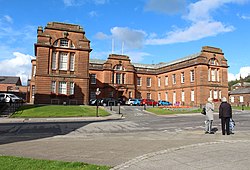 | |
| Council Offices, 113 English Street, Dumfries, DG1 2DD | |
| Website | |
| www | |
Administrative history
[edit]Prior to 1975, the area that is now Dumfries and Galloway was administered as three separate counties: Dumfriesshire, Kirkcudbrightshire, and Wigtownshire. The counties of Scotland originated as sheriffdoms, which were established from the twelfth century, consisting of a group of parishes over which a sheriff had jurisdiction.[36] An elected county council was established for each county in 1890 under the Local Government (Scotland) Act 1889.
The three county councils were abolished in 1975 under the Local Government (Scotland) Act 1973, which established a two-tier structure of local government across Scotland comprising upper-tier regions and lower-tier districts. A region called Dumfries and Galloway was created covering the area of the three counties, which were abolished as administrative areas. The region contained four districts:[37]
- Annandale and Eskdale, covering the eastern part of Dumfriesshire.
- Nithsdale, covering the western part of Dumfriesshire and a small part of Kirkcudbrightshire.
- Stewartry, covering most of Kirkcudbrightshire.
- Wigtown, covering all of Wigtownshire and a small part of Kirkcudbrightshire.[a]
Further local government reform in 1996 under the Local Government etc. (Scotland) Act 1994 saw the area's four districts abolished, with the Dumfries and Galloway Council taking over the functions they had previously performed.[39] The council continues to use the areas of the four abolished districts as committee areas. The four former districts are also used to define the area's three lieutenancy areas, with Nithsdale and Annandale and Eskdale together forming the Dumfries lieutenancy, the Stewartry district corresponding to the Stewartry of Kirkcudbright lieutenancy, and the Wigtown district corresponding to the Wigtown lieutenancy.[40]
The council headquarters is at the Council Offices at 113 English Street in Dumfries, which had been built in 1914 as the headquarters for the old Dumfriesshire County Council, previously being called "County Buildings".[41][42]
Political control
[edit]The first election to the Dumfries and Galloway Regional Council was held in 1974, initially operating as a shadow authority alongside the outgoing authorities until the new system came into force on 16 May 1975. A shadow authority was again elected in 1995 ahead of the reforms which came into force on 1 April 1996. Political control of the council since 1975 has been as follows:[43]
Regional council
| Party in control | Years | |
|---|---|---|
| Independent | 1975–1994 | |
| No overall control | 1994–1996 | |
Unitary authority
| Party in control | Years | |
|---|---|---|
| No overall control | 1996–present | |
Leadership
[edit]Since 2007 the council has been required to designate a leader of the council. The leader may also act as the convener, chairing council meetings, or the council may choose to appoint a different councillor to be convener.[44] Prior to 2007 the council sometimes chose to appoint a leader, and sometimes did not. The leaders since 2007 have been:[45]
| Councillor | Party | From | To | Notes | |
|---|---|---|---|---|---|
| Ivor Hyslop | Conservative | 15 May 2007 | 1 Oct 2013 | ||
| Ronnie Nicholson | Labour | 1 Oct 2013 | 23 May 2017 | ||
| Elaine Murray | Labour | 23 May 2017 | 5 May 2022 | ||
| Stephen Thompson | SNP | 24 May 2022 | 3 Feb 2023 | Co-leaders, with Thompson being the civic head and convener and Dorward being the depute convener. | |
| Linda Dorward | Labour | ||||
| Stephen Thompson | SNP | 3 Feb 2023 | 28 Feb 2023 | ||
| Gail Macgregor[46] | Conservative | 7 Mar 2023 | Malcolm Johnstone (CON) as Depute Leader of the Council and Convenor | ||
Composition
[edit]Following the 2022 election and subsequent by-elections and changes of allegiance up to July 2024, the composition of the council was:
| Party | Councillors | |
|---|---|---|
| Conservative | 16 | |
| SNP | 11 | |
| Labour | 8 | |
| Independent | 7 | |
| Liberal Democrats | 1 | |
| Total | 42 | |
Three of the independent councillors and the Liberal Democrat sit together as the 'Independent Group'. Another three independent councillors form the 'Democratic Alliance' group, and the other independent does not belong to a group.[47] The next election is due in 2027.[48]
Elections
[edit]Since 2007 elections have been held every five years under the single transferable vote system of election. This system was introduced by the Local Governance (Scotland) Act 2004 to achieve a reasonably proportionately representative outcome. Election results since 1995 have been as follows:[43]
| Year | Seats | Conservative | SNP | Labour | Liberal Democrats | Independent | Notes |
|---|---|---|---|---|---|---|---|
| 1995 | 70 | 2 | 9 | 21 | 10 | 28 | |
| 1999 | 47 | 8 | 5 | 13 | 6 | 15 | New ward boundaries.[49] |
| 2003 | 47 | 11 | 5 | 14 | 5 | 12 | |
| 2007 | 47 | 18 | 10 | 14 | 3 | 2 | New ward boundaries.[50] Conservative and SNP coalition. |
| 2012 | 47 | 14 | 10 | 15 | 1 | 7 | Conservative / SNP coalition until October 2013.[51] Labour / SNP coalition until June 2014.[52] Minority Labour administration 2014–2017. |
| 2017 | 43 | 16 | 11 | 11 | 1 | 4 | New ward boundaries.[53] Labour and SNP coalition. |
| 2022 | 43 | 16 | 11 | 9 | 1 | 6 | SNP and Independent Group Coalition with Labour support until February 2023.[54] Conservative minority administration from March 2023.[46] |
Wards
[edit]
The council area is divided into 12 wards that elect 43 councilors:
| Ward Number | Ward Name | Location | Seats |
|---|---|---|---|
| 1 | Stranraer and the Rhins | 
|
4 |
| 2 | Mid Galloway and Wigtown West | 
|
4 |
| 3 | Dee and Glenkens | 
|
3 |
| 4 | Castle Douglas and Crocketford | 
|
3 |
| 5 | Abbey | 
|
3 |
| 6 | North West Dumfries | 
|
4 |
| 7 | Mid and Upper Nithsdale | 
|
3 |
| 8 | Lochar | 
|
4 |
| 9 | Nith | 
|
4 |
| 10 | Annandale South | 
|
4 |
| 11 | Annandale North | 
|
4 |
| 12 | Annandale East and Eskdale | 
|
3 |
Parliamentary constituencies
[edit]Gallery
[edit]-
Dalveen Pass from Comb Head summit, near Thornhill, Dumfries and Galloway, Scotland.
-
Sweetheart Abbey, Dumfries and Galloway (Scotland)
-
Orchardton Tower, Dumfries and Galloway, Scotland
-
Caerlaverock National Nature Reserve. View across the Nith Estuary, close to the Solway Firth, Dumfries & Galloway.
-
Tongland Power station.
-
Mull of Galloway headland.
-
Mull of Galloway Lighthouse.
-
A Machars beach.
-
Machars Coastline looking south from Cruggleton Castle.
-
The remains of Cruggleton Castle.
-
The Machars, as viewed from Torrs Warren with Luce Bay standing between.
-
The Devil's Beef Tub.
-
Port William harbour.
-
River Nith Estuary.
See also
[edit]References
[edit]- ^ "Council and democracy". Dumfries and Galloway Council. Retrieved 15 September 2024.
- ^ a b "Mid-Year Population Estimates, UK, June 2022". Office for National Statistics. 26 March 2024. Retrieved 3 May 2024.
- ^ "Visit Southern Scotland".
- ^ "Home". Mull of Galloway.
- ^ "Home". www.theglenkens.org.uk.
- ^ "Society of Antiquaries of Scotland Proceedings of the Society Feb 11th 1924 ANCIENT BORDER HIGHWAYS by Harry R G Inglis" (PDF). Archived from the original (PDF) on 12 June 2007.
- ^ "Nith Estuary National Scenic Area". www.walkscotland.plus.com.
- ^ "Roman Britain - Organisation". Roman Britain. Archived from the original on 6 December 2009.
- ^ "Dumfries Museum – The Brow Well". Archived from the original on 4 February 2011. Retrieved 23 December 2009.
- ^ "Forestry Commission web page on Mabie Forest and its facilities".
- ^ "Scotland's Natural Nature Reserves page on the Kirkconnell Flow". Archived from the original on 10 March 2010. Retrieved 23 December 2009.
- ^ "National Museum of Costume web site". Archived from the original on 6 January 2010. Retrieved 23 December 2009.
- ^ "East Stewartry National Scenic Area Map, and Introduction to Coastal Walks in the Area". www.walkscotland.plus.com.
- ^ "Auchencairn Initiative walk from Balcary to Rascarrel". Archived from the original on 17 December 2009. Retrieved 23 December 2009.
- ^ "Mersehead Nature Reserve, Dumfries & Galloway, Scotland". The RSPB.
- ^ "Fleet Valley National Scenic Area". www.walkscotland.plus.com.
- ^ "Rallying cry from frog stronghold". BBC News. 6 May 2008.
- ^ "Mull Of Galloway Nature Reserve, Scotland". The RSPB.
- ^ "Wood Of Cree Nature Reserve, Dumfries & Galloway". The RSPB.
- ^ "Ken-Dee Marshes Nature Reserve, Dumfries & Galloway". The RSPB.
- ^ "7stanes mountain biking - Forestry and Land Scotland". forestryandland.gov.scot.
- ^ "Route 7 on Sustrans website". Archived from the original on 10 March 2013.
- ^ "Moffat Hills Introduction showing Hill Walk Routes and Local Information". www.walkscotland.plus.com.
- ^ "Hillwalking in the Durisdeer and Lowther Hills - Introduction". www.walkscotland.plus.com.
- ^ "Hill Walking in the Scaur or Carsphairn Hills - Introduction, Scotland". www.walkscotland.plus.com.
- ^ "Hill Walking Routes in Galloway - Introduction". www.walkscotland.plus.com.
- ^ "Website for the Southern Upland Way". Archived from the original on 29 April 2012. Retrieved 23 February 2012.
- ^ "Annandale Way - Welcome". annandaleway.org.
- ^ "Annandale Sailing Club : Home". Annandale Sailing Club.
- ^ "Loch Ken Marina - Water Sports & Water Skiing in Dumfries and Galloway". www.lochken.com.
- ^ "Airds Farm Guest House | Bed and Breakfast Accommodation | Dumfries and Galloway". www.airds.com. Archived from the original on 10 March 2013.
- ^ "Newspaper Indexes". Dumfries & Galloway Council. Retrieved 27 February 2024.
- ^ "Mid-2020 Population Estimates for Settlements and Localities in Scotland". National Records of Scotland. 31 March 2022. Retrieved 31 March 2022.
- ^ "Home". Devils Porridge Museum.
- ^ "Dumfries and Galloway Council appoints new Chief Executive". Dumfries and Galloway Council. 6 April 2022. Retrieved 10 March 2023.
- ^ "Type details for Scottish County". Vision of Britain. Retrieved 16 August 2021.
- ^ "Local Government (Scotland) Act 1973", legislation.gov.uk, The National Archives, 1973 c. 65, retrieved 22 November 2022
- ^ "The Lord-Lieutenants Order 1975", legislation.gov.uk, The National Archives, SI 1975/428, retrieved 27 November 2022
- ^ "Local Government etc. (Scotland) Act 1994", legislation.gov.uk, The National Archives, 1978 c. 39, retrieved 22 November 2022
- ^ "The Lord-Lieutenants (Scotland) Order 1996", legislation.gov.uk, The National Archives, SI 1996/731, retrieved 22 November 2022
- ^ Historic Environment Scotland. "English Street, County Buildings (LB26174)". Retrieved 10 March 2023.
- ^ "Dumfries, 113 English Street, Dumfries County Buildings". Canmore. Historic Environment Scotland. Retrieved 10 March 2023.
- ^ a b "Compositions calculator". The Elections Centre. Retrieved 6 November 2022.
- ^ "The Local Governance (Scotland) Act 2004 (Remuneration) Regulations 2007", legislation.gov.uk, The National Archives, SI 2007/183, retrieved 27 November 2022
- ^ "Council minutes". Dumfries and Galloway Council. Retrieved 27 November 2022.
- ^ a b McLean, Marc (10 March 2023). "Dumfries and Galloway Council power takeover leads to even more political unrest". Daily Record. Retrieved 10 March 2023.
- ^ "Your councillors by political grouping". Dumfries and Galloway Council. Retrieved 30 July 2024.
- ^ "Dumfries and Galloway". Local Councils. Thorncliffe. Retrieved 30 July 2024.
- ^ "The Dumfries and Galloway (Electoral Arrangements) Order 1998", legislation.gov.uk, The National Archives, SI 1998/3180, retrieved 29 January 2023
- ^ Scottish Parliament. The Dumfries and Galloway (Electoral Arrangements) Order 2006 as made, from legislation.gov.uk.
- ^ "Dumfries and Galloway Council deadlock meeting planned". BBC News. 28 September 2013. Retrieved 28 September 2013.
- ^ "SNP quits Dumfries and Galloway Council ruling coalition". BBC News. 2 June 2014.
- ^ Scottish Parliament. The Dumfries and Galloway (Electoral Arrangements) Order 2016 as made, from legislation.gov.uk.
- ^ McLean, Marc; Standard, Dumfries and Galloway (7 February 2023). "Council coalition hangs on to power". Daily Record. Retrieved 8 February 2023.
External links
[edit] Media related to Dumfries and Galloway at Wikimedia Commons
Media related to Dumfries and Galloway at Wikimedia Commons- Video footage and history of Kirkpatrick Irongray Church
 KSF
KSF

















